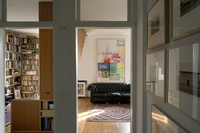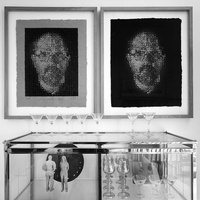Texts from biography/essay Between two worlds. Story of Philip Rolla by Maria Grazia Rabiolo.
You can download a short biography here.
-
AMERICA, CALIFORNIA
Philip Rolla left California in 1962 to realize his dream of building propellers for fast boats, and he knew that only in Turin could he learn all the secrets of the trade. That would be his first destination. When he left, he was 24 years old and had just graduated from the University of Santa Clara with a degree in Economics and Industrial Engineering, but he had already shown that he was able to build a racecar and a raceboat (with which he competed), and to draw and paint. He will never forget his paternal home in Madrone, surrounded by orchards, nor the years he spent with his parents, brother and grandparents. He treasured all his experiences and began his own adventure, retracing in reverse the path taken by his four Piedmontese grandparents around 1910.
continue...
-
ITALY, TURIN
Philip Rolla arrived in Turin between 1962 and 1963, after visiting several European cities and Italian regions, including Piedmont, more precisely Monferrato, where he met his grandparents’ relatives and friends. He did not have a penny in his pocket, but he was lucky enough to meet some people who would be fundamental to his training: the coachbuilder and designer Giovanni Battista Pininfarina, the “engine wizard” Virgilio Conrero and, above all, the Hungarian Frank Reisner, who taught him how you make cars. Two years of apprenticeship without salary, but with board and lodging. In the meantime he made his first contacts with the motorboat world overseas, and for the California
continue...ntycoon Bill Harrah he made his first important invention, a three-blade propeller for very high speeds, an international first. It was also during this period that he met love. In Finale Ligure he met Renate Michel, and some time later he moved with her to Switzerland, to the canton of Ticino. -
SWITZERLAND, TESSIN
The arrival in Switzerland was in the winter of 1964-1965. Philip Rolla lived with Renate first in Pregassona, then in Lugano Besso and later in Vernate, Malcantone. In 1968 they settled on the shores of Lake Ceresio, in Pojana, between Riva San Vitale and Brusino Arsizio, in an old restaurant called “Al San Giorgio”. Phil occupies the garage and turns it into a perfect workshop with all his tools. There, under a parachute canopy, he plunges into the creation of ever more innovative and faster propellers, following his personal instincts of mathematical calculation and manual dexterity. He went so far as to make propellers with eight blades! During this time, he was fortunate enough to make friends with some people from Ticino who helped him understand how to move in an environment that was so new to him: Remo Cattaneo, Carlo Ortelli and Dolf Schnebli, the master architect of reinforced concrete. Philip stayed in Pojana until 1986, when, as a widower, he moved to the old cement factory in the Breggia Valley in Balerna.
continue... -
THE FASTEST PROPELLERS IN THE WORLD
There is a secret to Philip Rolla’s success: he believes in beauty. The same goes for his propellers: to perform at their best, they must be aesthetically appealing. How does he achieve this? By completing each creation with the last fundamental touch of the artisan’s hand. From the very first, created in Turin, to the latest, the result of the most advanced techniques, it is this last step that makes all the difference. Customers of racing boats, pleasure craft, luxury yachts, military vessels or ferries know this well. It has also been recognized by the Royal Institution of Naval Architects (Rina), which awarded him the prestigious Small Craft Group Medal for his life's work on propellers in London in 2000. Propellers play a crucial role; they are the starting point in the design process of any boat. This is the principle of Phil’s success.
continue...
-
ROLLA BLUE
Philip Rolla’s entire career is metaphorically represented by the transition from the letterhead with the name Motonautica, the post office box and the stamp of the American Chamber of Commerce in plain view, in 1963, when he had just arrived in Turin, to ROLLA, written in capitals, stenciled, in an unmistakable blue that resembles both water and sky, which is still present today. Rolla SP Propellers is no longer located in the Breggia Valley, but in Novazzano since 2005. Many things have changed, Phil has retired from the current business, but his mind and hands are still in action. In his past are the most imaginative construction sites, his closest collaborators and innovative engineers. In short, there is an awareness of the value of teamwork that complements his staff as they constantly adapt to new means and technologies. These are fundamental experiences that will be indispensable when he later embarks on new projects, such as those in the field of collecting art and photography.
continue... -
IN THE ART WORLD
Philip Rolla’s love of the fine arts goes back to his childhood, when he made copies of Michelangelo’s works and sold them for pennies to his father’s friends. In elementary and high school, he excelled in drawing. As an adult, he continued to work with a pencil, but also developed an interest in contemporary art, especially American Minimalism. Two friends from Ticino, the sculptor Pierino Selmoni and the painter Flavio Paolucci, introduced to Phil by the architect Dolf Schnebli, brought him closer to this art in the 1960s and 1970s. Three decisive figures in his cultural formation. Schnebli opened his eyes to the concept of the house as a “living machine”, Selmoni introduced him to the artistic milieu of Ticino, and Paolucci led him to broaden his cognitive horizons. It was thanks to Paolucci, for example, that he “discovered” Richard Long’s aligned stones in Venice in 1976.
continue...
-
COLLECTING
Collecting works of art, especially by American minimalist artists, and photography is an activity that Philip Rolla has cultivated for decades with great satisfaction, both for himself and for his wife Rosella. His proximity to these artists has also always had a great influence on the way he conceives his work. The first two works that he and his wife Rosella bought, after those of his Ticino friends Pierino Selmoni and Flavio Paolucci in the 1970s, were a small rectangular painting with a horizontal parallelepiped by Sol LeWitt and a kind of flip-book by Robert Rauschenberg, a real “bible” for Phil. The interest in photography comes shortly thereafter, in the early 2000s. And the first new entries, a short time apart, were an image of a bathroom in a Mies Van Der Rohe house by the German photographer Thomas Ruff and a sea horizon by the Japanese photographer Hiroshi Sugimoto.
continue...

-
BORGOVICO33, COMO
Philip and Rosella Rolla see art as a valuable asset to be shared with friends, enthusiasts and even the simply curious. With this generous and innovative spirit, they founded the cultural association borgovico33 in 2002. Rosella is the director and coordinator of the scientific committee. Inspired by the Texas artist Donald Judd’s Chinati Foundation in Marfa, they chose as their headquarters the former church of the convent of Santa Caterina in Como, a 1634 building that had been used for various purposes over the centuries and then abandoned. The architect Paolo Brambilla renovated it with delicate and conservative touch. Over a period of seven years, photographers, artists, musicians, actors and architects from Italy, Switzerland and abroad took part in a total of twenty-five events. The series opened in April 2002 with the exhibition Pino Musi, Giuseppe Terragni, and Franco Vimercati. A Journey to the Purity of the Image. Photographs from 1973 to 2001 concluded the series in the first half of 2008. A photographer at the beginning of the adventure and a photographer to seal it. Certainly not by chance.
continue...




-
ROLLA FOUNDATION, BRUZELLA
The passion for photography grows year by year and so does the archive of the collection. Philip Rolla is interested in the image that portrays the object as it is, without forcing it, but with a special view point capable of returning a deep emotional response to it. This is the lesson he learned from reading John Szarkowski’s The Photographer’s Eye, and it applies to all the subjects he loves: architecture, factories, objects, plants.
Since 2010, this legacy has been made available to those interested. Rosella and Philip Rolla reached an agreement with the Municipality of Bruzella (now Breggia) for the use of the former kindergarten. Here they systematically offer thematic exhibitions. By a single author, collective or in the form of a dialogue between two, each exhibition is accompanied by a small and valuable catalog
ue. The first appointment was with the Czech photographer Josef Sudek. The title of the exhibition: Cacciatore di magia. Volume cover in yellow. Introductory text signed by the Ticino poet Alberto Nessi.
continue...














